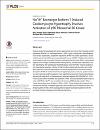Na+/H+ exchanger isoform 1 induced cardiomyocyte hypertrophy involves activation of p90 ribosomal S6 Kinase

View/
Date
2015-04Author
Jaballah, MaiyMohamed, Iman A.
Alemrayat, Bayan
Al-Sulaiti, Fatima
Mlih, Mohamed
Mraiche, Fatima
...show more authors ...show less authors
Metadata
Show full item recordAbstract
Studies using pharmacological and genetic approaches have shown that increased activity/expression of the Na+/H+ exchanger isoform 1 (NHE1) play a critical role in the pathogenesis of cardiac hypertrophy. Despite the importance of NHE1 in cardiac hypertrophy, severe cerebrovascular side effects were associated with the use of NHE1 inhibitors when administered to patients with myocardial infarctions. p90 ribosomal S6 Kinase (RSK), a downstream regulator of the mitogen-activated protein kinase pathway, has also been implicated in cardiac hypertrophy. We hypothesized that RSK plays a role in the NHE1 induced cardiomyocyte hypertrophic response. Infection of H9c2 cardiomyoblasts with the active form of the NHE1 adenovirus induced hypertrophy and was associated with an increase in the phosphorylation of RSK (P<0.05). Parameters of hypertrophy such as cell area, protein content and atrial natriuretic mRNA expression were significantly reduced in H9c2 cardiomyoblasts infected with active NHE1 in the presence of dominant negative RSK (DN-RSK) (P<0.05). These results confirm that NHE1 lies upstream of RSK. Increased phosphorylation and activation of GATA4 at Ser261 was correlated with increased RSK phosphorylation. This increase was reversed upon inhibition of RSK or NHE1. These findings demonstrate for the first time that the NHE1 mediated hypertrophy is accounted for by increased activation and phosphorylation of RSK, which subsequently increased the phosphorylation of GATA4; eventually activating fetal gene transcriptional machinery.
Collections
- Pharmacy Research [1440 items ]
Related items
Showing items related by title, author, creator and subject.
-
The Role of Epidermal Growth Factor Receptor Family of Receptor Tyrosine Kinases in Mediating Diabetes-Induced Cardiovascular Complications
Shraim B.A.; Moursi M.O.; Benter I.F.; Habib A.M.; Akhtar S. ( Frontiers Media S.A. , 2021 , Article)Diabetes mellitus is a major debilitating disease whose global incidence is progressively increasing with currently over 463 million adult sufferers and this figure will likely reach over 700 million by the year 2045. It ... -
Universal Genetic Testing for Newly Diagnosed Invasive Breast Cancer
Rezoug, Zoulikha; Totten, Stephanie P.; Szlachtycz, David; Atayan, Adrienne; Mohler, Kristen; Albert, Sophie; Feng, Leila; Lemieux Anglin, Brianna; Shen, Zhen; Jimenez, Daniel; Hamel, Nancy; Meti, Nicholas; Esfahani, Khashayar; Boileau, Jean-François; Prakash, Ipshita; Basik, Mark; Meterissian, Sarkis; Tremblay, Francine; Fleiszer, David; Anderson, Dawn; Chong, George; Wong, Stephanie M.; Foulkes, William D.... more authors ... less authors ( American Medical Association , 2024 , Article)IMPORTANCE Between 5% and 10% of breast cancer cases are associated with an inherited germline pathogenic or likely pathogenic variant (GPV) in a breast cancer susceptibility gene (BCSG), which could alter local and systemic ... -
Na+/H+ exchanger isoform 1-induced osteopontin expression facilitates cardiomyocyte hypertrophy
Mohamed, Iman A.; Gadeau, Alain-Pierre; Fliegel, Larry; Lopaschuk, Gary; Mlih, Mohamed; Abdulrahman, Nabeel; Fillmore, Natasha; Mraiche, Fatima... more authors ... less authors ( Public Library of Science , 2015 , Article)Enhanced expression and activity of the Na+/H+ exchanger isoform 1 (NHE1) has been implicated in cardiomyocyte hypertrophy in various experimental models. The upregulation of NHE1 was correlated with an increase in osteopontin ...



